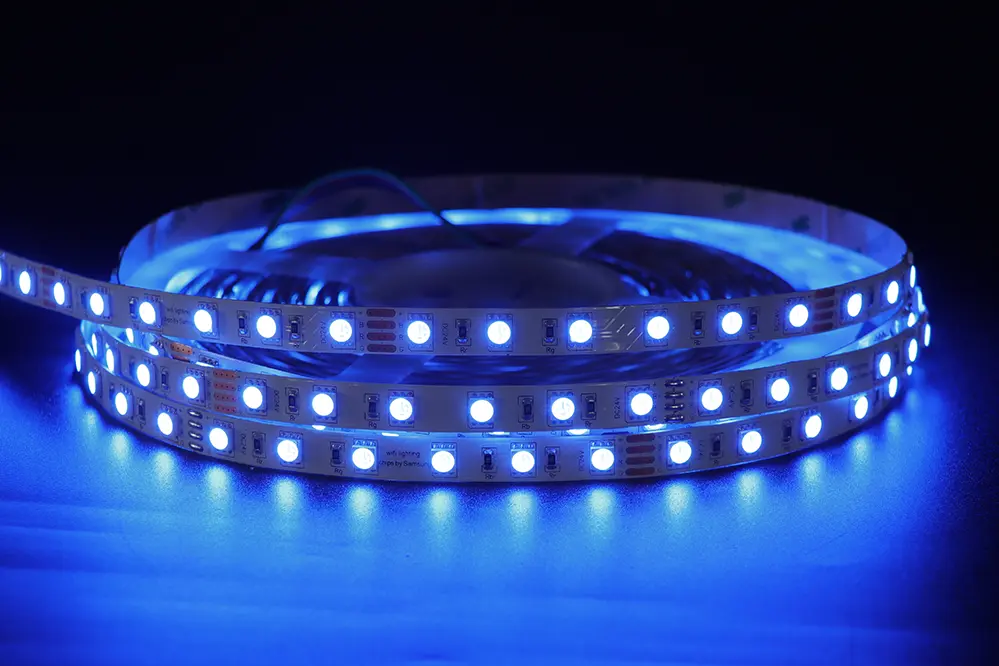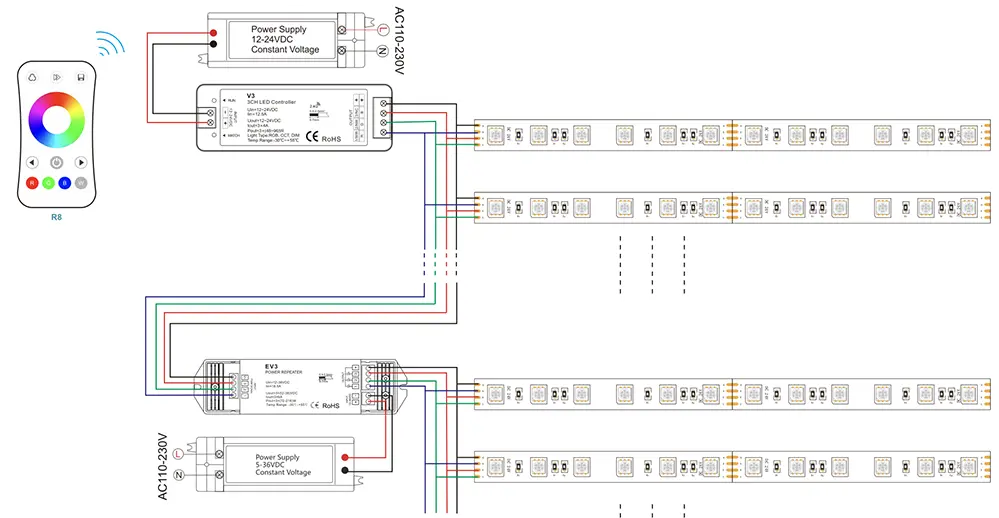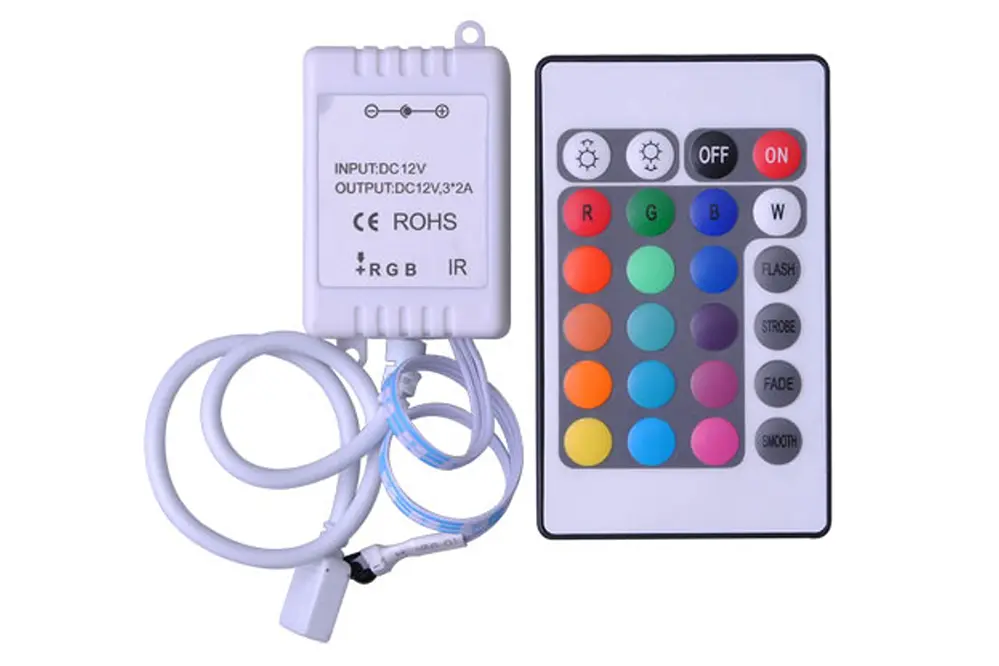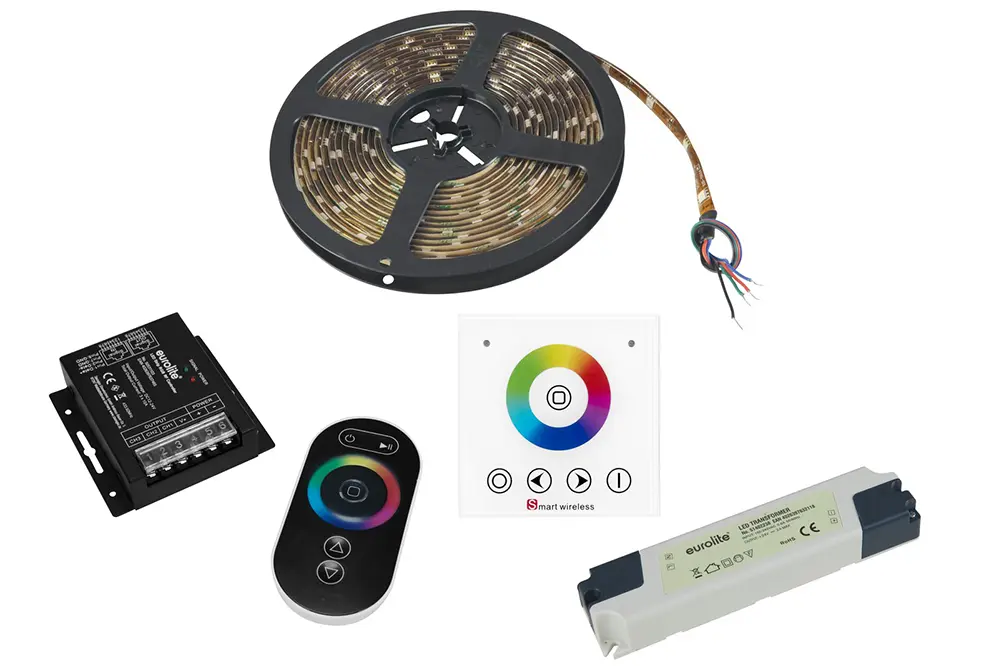If you’ve ever experienced your LED strip lights turning blue instead of off, you’re not alone. This common issue can be both perplexing and inconvenient, disrupting the ambiance you’ve carefully curated.
Addressing this problem is important, as LED lights are a key component in creating energy-efficient and customizable lighting environments. Fortunately, there are several solutions available, ranging from adjusting controller settings to checking wiring connections.
In this article, we’ll delve into these options, offering insights and tips to help you resolve the issue and optimize your lighting setup.
Common Causes of Blue LED Lights

One common cause for this phenomenon is faulty or incompatible remote control settings.
Many LED systems rely on a remote control that operates via infrared signals or wireless connections, which can sometimes go awry, mistakenly triggering the blue light channel. Imagine setting the ambiance for a cozy evening, only to be met with unintentional blue hues because of an incorrectly interpreted signal. Troubleshooting these settings or replacing the remote might restore your desired tranquility.
Incidentally, faulty wiring is another frequent culprit in this situation. When wires are not properly connected or become loose, the electrical signals intended to toggle the lights off may instead activate the blue diodes, creating an unintended visual effect.
Lastly, there might be fundamental software issues within the light controller itself. These controllers can occasionally experience glitches, causing the lights to default to blue. A software reset or firmware update often rectifies these types of bugs, allowing your LED lights to return to their intended off state, ensuring that your desired atmosphere is effortlessly maintained.
Understanding LED Light Color Change
The transition to blue can be perplexing.
Primarily, this phenomenon arises from the intricate engineering and technology behind LED systems. These light-emitting diodes rely on precise manipulation of color channels, where an imbalance can shift the hues unexpectedly. Essentially, if there is an improper distribution of energy, blue light may dominate the spectrum inadvertently.
Such changes indicate potential misconfigurations.
The blue hue, often linked to an electrical or signal discrepancy, highlights the remarkable sensitivity of these advanced lighting solutions. It’s a subtle reminder of how integral seamless electronic communication is to achieving consistent performance across technology.
Through awareness and proactive steps, the mysteries of electronics can be unraveled, empowering users to master their device settings confidently. Harnessing knowledge about these color shifts helps in anticipating and resolving issues efficiently. This enlightening journey enhances not only technical skills but also the user experience, transforming potential frustrations into spectacular successes.
Faulty Wiring Issues

When LED strip lights turn blue instead of off, wiring problems might be at play.
In some instances, the issue is a simple crossed wire within the lighting setup, where the intended connections are inadvertently switched, causing the LED driver to misinterpret the command to power down fully. This could result in the blue LED channel remaining powered, thus, maintaining a blue light emission despite the device being turned off.
Additionally, there may be a disruption in a grounding connection that influences current flow. An incomplete circuit bond may leave some LEDs partially energized, which could, in turn, trigger the blue spectrum to shine unexpectedly even in an off state.
Ultimately, a detailed examination of the wiring might be essential in resolving errant lighting behaviors. Enlists the assistance of knowledgeable professionals to decipher the complex networks that enable LED functionality, ensuring safe and optimal illumination. This expertise can breathe new life into your lighting system, transforming potential pitfalls into moments of luminosity and clarity.
Incorrect Driver Settings
If your LED strip lights turn blue instead of off, incorrect driver settings might be the underlying issue. It’s a conspicuously subtle yet pivotal aspect of lighting management.
The driver controls the current to the LEDs, and settings misalignment can skew performance. When attributes do not accurately align, LED behavior deviates.
Notably, a pervasive setting mismatch often occurs within RGB lighting schemes, where improper configuration leads to unexpected hues. It might be as nuanced as setting intensities incorrectly.
These misalignments may also derive from pre-set manufacturer defaults. Such settings resist adjustments, sometimes thwarting desired outcomes absent intentional reprogramming.
Ensuring driver settings align with your specific LED requirements involves both familiarity with technology and consideration for the system’s workflow. An empowering opportunity exists to engage with detailed manuals or consult experienced technicians, catalyzing troubleshooting into a seamless adventure.
Ultimately, the path to perfect lighting is not elusive. With strategic adjustments and informed involvement, achieving your ideal ambiance transcends being a mere aspiration and instead becomes your illuminating reality.
Remote Control Malfunctions

Remote control malfunctions might inadvertently cause your LED strip lights to turn blue instead of off.
In some cases, these issues can stem from incorrect signal transmissions (“off” signals being misread as blue), often due to interference from other electronic devices, which can complicate proper remote functionality.
Testing the “on-off” and “color change” buttons can distinguish whether communication is the remote’s shortcoming.
Troubleshooting Remote Problems
Innovative solutions are just a few mindful adjustments away. First, inspect if the remote’s battery life impacts its ability to communicate effectively, potentially causing your LED strips to malfunction.
Explore the distance between the remote and the receiver, as losing signal strength could lead to unintended color changes. Consider repositioning for optimal connectivity and performance enhancement.
Proper positioning of your LED strip receiver can significantly boost response accuracy and reduce unintended color changes.
Confirm button functionality: press each button to ensure accurate commands are transmitted. If issues persist, reprogram the remote following the manufacturer’s instructions for guided realignment.
Inconsistent Power Supply
Perhaps it’s the subtle dance of electrical currents, a symbol of technological intricacy, where issues arise. Inconsistent power supply can, at times, lead your LED strip lights to remain on a blue hue instead of turning completely off, much to the bewilderment of any tech enthusiast. Remember, this seemingly small impediment can be remedied with careful examination and strategic adjustments to power sources, ensuring your LED experience is as vibrant and reliable as your vision dreams it to be.
Checking Power Connections
Reassess the power connection integrity.
The mysterious shift in LED strip lights turning blue instead of off might very well be linked to power connections that have become less than ideal. Ensure the power adapter is adequately secured to its connection, examining any signs of wear or corrosion that might impede proper energy flow. Additionally, consider if the socket or extension cord you’re using has been compromised in functionality, as these can profoundly influence the LED strip lights’ behavior.
Notably, power supply variations can affect color.
A consistent power supply should ideally yield consistent outcomes – yet the misalignment of connections might cause sporadic behavior in LED lights, such as the prevalent blue hue. Exploring alternative power connections might uncover previously overlooked anomalies.
Inspirationally, attending to these infrastructural details yields impressive improvement prospects, breathing new life into your LED strips. Embrace the ease of maintenance as an ongoing commitment to securing invigorating ambiance control, inviting all potential transformations through simple, thoughtful adjustments.
LED Strip Control Failures
Control failures represent a fascinating challenge for LED strip enthusiasts who seek to troubleshoot, innovate, and unravel a multitude of solutions.
Improper controller configurations may cause unexpected behaviors like turning blue.
These issues are frequently due to synchronization errors that can lead to a variety of colors displaying incorrectly, potentially as a result of a mismatch or interference, pushing users into a journey of rediscovery, problem-solving, and advancement.
The promise of persistence lies in the exquisite journey to rectify the universal issue of a misunderstood control mechanism for LED systems, as it turns into an adventure of limitless learning and discovery. So take heart, consider the “reset” as an opportunity to elevate your understanding and mastery.
Impact of Dimmer Switches
Dimmer switches offer an enhanced level of brightness control and can profoundly impact LED behavior, thus inviting new advancements in ambiance and energy efficiency, which leads to resourceful lighting options.
Occasionally, these devices might cause unexpected color changes like blue light when off.
This behavior may stem from residual voltage that fails to fully power down the LEDs, resulting in faint emissions particularly noticeable in certain color spectra, a characteristic trait of technological nuances which continues to evolve.
To successfully navigate these illuminating challenges, ensure compatibility between your LED strips and dimmers. This can mean selecting dimmers designed for low wattages or consulting professionals who can guide you towards obtaining optimal LED performance. Embrace these adjustments as opportunities to bolster sustainability, ensuring your space remains beautifully lit and intelligently managed.
Compatibility with Controllers

The seamless integration of LED strip lights with controllers defines the pinnacle of lighting personalization. With technological advances, a myriad of controller options synchronize perfectly with LED systems, producing captivating results.
Not every controller aligns with every LED product. The challenge lies in identifying the ideal match.
Incompatible controllers may trigger unexpected behaviors, such as LEDs turning blue instead of off. Understanding this is crucial.
Opt for controllers explicitly designed for LED systems to guarantee flawless operation. These smart solutions often mitigate incompatibilities.
Certified controllers promote not only synergy but also extend the lifespan and performance of your lighting solutions. They pave the path toward achieving comprehensive illumination goals.
Ultimately, the quest for perfect compatibility demands diligence and experimentation. Rise to the challenge by continually seeking better, smarter lighting solutions.
Effects of Temperature on LEDs
Temperature has a profound impact on LED performance, longevity, and efficiency. LEDs are known for their durability but remain sensitive to temperature variations.
Excessive heat can shorten the lifespan of LEDs. Therefore, effective thermal management is essential.
Conversely, lower temperatures generally enhance the lifespan and efficiency of LEDs. Cold environments, within reason, are beneficial.
Some LEDs may change color due to temperature fluctuations, altering the light output’s hue. Swift adaptation is critical.
Understanding thermal dynamics helps innovate solutions for temperature-related challenges, facilitating advances in LED technology. Embrace this knowledge as a catalyst for exceptional lighting outcomes.
Ultimately, by mastering temperature effects, you can elevate your LED systems for optimized performance. Prevailing through these challenges empowers you to illuminate the future with confidence and precision.
Identifying Manufacturing Defects
In the quest for optimal LED performance, identifying manufacturing defects is crucial to ensure the highest quality output.
Occasionally, you might encounter blue-tinted LEDs instead of expected off states, indicating a potential issue. This is often due to flawed components or inconsistencies during the production phase that affect color accuracy and functionality.
Ask questions such as “What might have caused these issues?” This exploration paves the way to ‘illuminate solutions’.
Recognizing Poor-Quality Strips
Encountering LED strip lights that turn blue instead of off may hint at underlying quality issues, and this could stem from a range of manufacturing shortcomings.
A preeminent sign of poor-quality strips includes imperfections in diode construction.
Such diodes might fall short due to inadequate phosphor coating or mismatched components, resulting in a hue that lingers rather than ceasing illumination as intended. Accordingly, ensuring that your LED purchases are backed by reputable brands can mitigate such risks.
It is essential to understand that not all LED strips are manufactured with the same rigorous standards. When faced with discrepancies such as unexpected blue hues, it’s vital to scrutinize the integrity, transparency, and reliability of the sources of your components. By adopting a discerning approach, you fortify your selection process, aligning your lighting solutions with excellence and reliability. In doing so, you not only elevate the quality of your illumination projects but also empower your initiatives with steadfast brilliance and unwavering innovation.
DIY Solutions to Fix Blue LED Issue
When your LED strip lights turn blue instead of off, take heart; solutions abound, empowering you to regain control over your lighting environment and restore the intended ambiance.
Begin by examining your remote’s battery life. A weak connection weakens signals.
Thirdly, consider reassessing the connection points for secure and reliable contacts.
Redeploy the setup using new connectors, ensuring each component fits securely, fostering a robust connection.
If grounding issues persist, engage a grounding wire to stabilize and balance electrical flow, alleviating voltage irregularities.
Finally, embrace the challenge as an opportunity to elevate your skills. Each fix empowers further mastery.
When to Consult a Professional
There comes a time to seek expert advice.
While many issues can be resolved through DIY efforts, some challenges require the nuanced expertise of professional technicians. Should you find yourself continuously facing the same problem despite multiple attempts of troubleshooting, it might be time to consider professional involvement. Additionally, experts can help identify underlying issues that remain unaddressed, ensuring a thorough resolution.
Don’t hesitate to call in expert help.
Complex wiring concerns can also benefit from professional insights—if you suspect that your circuitry demands an expert’s assessment, it’s best to enlist experienced electrical professionals for a reliable intervention.
Expert consultations can significantly enhance your troubleshooting experience, preventing any prolonged disruptions of lighting harmony. Furthermore, by engaging knowledgeable professionals in 2023, you secure not only the solution but also precognition of emerging trends. Such professional insights foster educational growth and safeguard potential obstacles, ensuring unwavering confidence in your lighting stewardry.
Preventing Future LED Color Problems
To alleviate recurrent issues with LED strip lights turning blue, proactive measures, such as consistent maintenance, a vigilant awareness of potential technical hiccups, and adopting an anticipatory troubleshooting approach, offer invaluable long-term benefits.
Utilizing these preventative steps will lay the groundwork for a more harmonious lighting experience.
Firstly, regularly updating the LED controller and firmware, if applicable (manufacturer instructions permitting), is recommended.
Such updates help to mitigate software anomalies or compatibility issues, preventing undesired color changes.
Equipping yourself with an in-depth understanding of your LED system, including common faults, empowers you to quickly identify discrepancies, ensuring faster resolutions and more sustained peace of mind.
Ultimately, the key is to ensure one’s grasp of foundational knowledge. Remaining informed provides the foresight needed to address future challenges head-on.
Conclusion
Resolving the issue of LED strip lights turning blue instead of off requires a blend of persistence, strategic insight, and proactive problem-solving. By understanding the intricacies of LED systems, you can transform your lighting experience, ensuring it aligns with your vision for ambiance and functionality. Armed with comprehensive knowledge, you can confidently navigate the spectrum of possibilities, optimizing your setup for the best possible outcomes. This approach not only addresses immediate concerns but also sets the stage for a more efficient and aesthetically pleasing environment.
Continual research and attention to innovative solutions are essential in paving the way for breakthroughs that transcend conventional perceptions of lighting. As technological advancements progress at an unprecedented pace, embracing these changes opens up new opportunities for excellence in illumination. By staying informed and adaptable, you can achieve lasting satisfaction and enhanced lighting experiences. Let your curiosity and determination guide you, as your commitment to mastering LED intricacies will yield significant rewards in both functionality and design.





